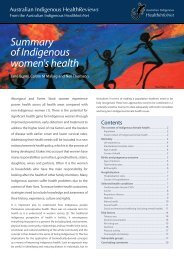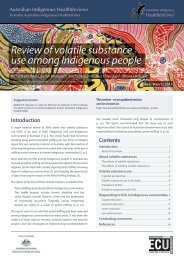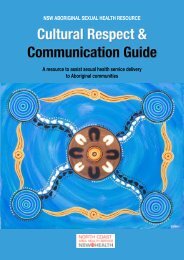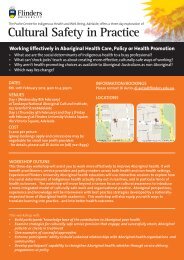hearing loss and the criminal justice system - Australian Indigenous ...
hearing loss and the criminal justice system - Australian Indigenous ...
hearing loss and the criminal justice system - Australian Indigenous ...
Create successful ePaper yourself
Turn your PDF publications into a flip-book with our unique Google optimized e-Paper software.
Senate Inquiry March 2010_________________________________________________________________________________________________________________It was not only in classrooms that listening problems related to Conductive Hearing Loss <strong>and</strong>background noise were evident. Student interviews highlighted <strong>the</strong> problems that resultedfrom background noise on playgrounds. It is generally assumed that students have <strong>the</strong>opportunity to freely socialise in <strong>the</strong> playground during break times. The comments oftargeted students suggest that, for children with Conductive Hearing Loss, this is often not<strong>the</strong> case.The reality that was revealed, was one in which Conductive Hearing Loss <strong>and</strong> high levels ofbackground noise combined to restrict verbal communication opportunities on <strong>the</strong>playground, in <strong>the</strong> same way as it did in classrooms. The high levels of background noise,especially around play equipment <strong>and</strong> in group games, inhibited verbal communication formany children with Conductive Hearing Loss. Restricted verbal communicationopportunities in noisy playgrounds prompted social involvement through teasing, as it did inclassrooms. In <strong>the</strong> less teacher‐controlled playground, this was more likely to result inphysical fights.When classroom peers of children with <strong>hearing</strong> <strong>loss</strong> were asked about <strong>the</strong>ir experiences inrelation to <strong>the</strong>se children, <strong>the</strong>y spoke of being teased by <strong>the</strong> children with <strong>hearing</strong> <strong>loss</strong>,having <strong>the</strong>ir possessions taken, <strong>the</strong>ir access to classroom materials was denied <strong>and</strong> <strong>the</strong>ywere often pushed, prodded <strong>and</strong> poked. Fur<strong>the</strong>r, <strong>the</strong>ir comments in conversation wereoften ignored or misunderstood by <strong>the</strong> children with <strong>hearing</strong> <strong>loss</strong>; <strong>the</strong>y were bossed <strong>and</strong>told what <strong>the</strong>y should be doing, as well as told on to <strong>the</strong> teacher. It was not surprising that<strong>the</strong>se students with Conductive Hearing Loss were often not liked by <strong>the</strong>ir peers.Social problems in childhood are likely to result in problems in later social <strong>and</strong> psychologicaladjustment. Levine (1966) found <strong>the</strong> quality of <strong>the</strong> interpersonal relations that childrenestablish with <strong>the</strong>ir peers during <strong>the</strong>ir school years, is linked to later success outside ofschool. Fur<strong>the</strong>rmore, problems in relating to peers in childhood have been found to beassociated with psychological difficulties during adolescence (Brown, Bhrolchain & Harris,1975; Miller & Ingham, 1976; Parker & Asher, 1987).It is suggested that <strong>the</strong> single best childhood predictor of adult adaptation is <strong>the</strong> adequacywith which <strong>the</strong> child gets along with o<strong>the</strong>r children. Children who are generally disliked,who are aggressive <strong>and</strong> disruptive, who are unable to sustain close relationships with o<strong>the</strong>rchildren, or who cannot establish a place for <strong>the</strong>mselves in <strong>the</strong> peer culture, are seriously atrisk of problems in adulthood (Hartup, 1992). Children who are rejected by peers reportloneliness <strong>and</strong> social dissatisfaction (Asher & Wheeler, 1985), have more difficulties learning(Amidon <strong>and</strong> Hoffman, 1965), <strong>and</strong> are at risk of adjustment problems such as dropping outof high school, juvenile delinquency, <strong>and</strong> mental health problems in adulthood (Parker &Asher, 1987)._________________________________________________________________________________________________________________39 Phoenix Consulting








